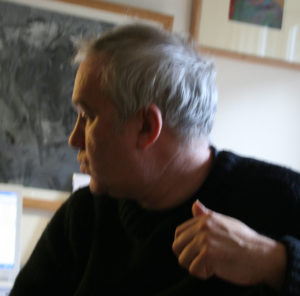
Artist statement
It is a truism that if one could put visual work into words, then there would be no need for it. The most I can do is to give some pointers.
The origin is not knowing: the impossibility of making the first mark. A reality so complex that one could spend several lifetimes trying to understand one square centimetre of it.
My vulnerability and strength is that I missed out on the comforting myth that one can accurately image the World. One can immediately recognise what a photograph represents, but that facsimile says almost nothing about what we experience. We learn the pretence of representation at around nine years old but I completely missed out on that experience.
Usually the only way I can begin to succeed is by letting go of caution and logic and allowing my hand do what it will.
My paintings are on paper. I value the smooth unyielding unique surface and for me no other material will work as well. The portability of paper suits my lifestyle and temperament. I can easily carry a whole body of work from one place to another.
My work is domestic in scale. I am comfortable with the idea that my work will be owned and viewed over a long period of time. One rarely gets a lot of time with a piece in a public gallery. I greatly value time, understatement and memory.
Most art (theatre, opera, dance, music, film) anticipates and incorporates an audience. I have never understood why Fine Art should be the exception.
When I work with a model, I regard her as an explicit collaborator in making the image.
Text and painting are like arguing siblings who can’t avoid each other’s company. Visual art shouldn’t be the servant of a text. I don’t support textual iconoclasm.
The work of the artist Jenny Holzer started my long standing preoccupation with short, punchy, ambiguous and provocative texts long before mobile phones, SMS and Twitter. The death of a close friend from Motor Neuron Disease added poignancy and immediacy to this preoccupation. At the end she was mute and could only communicate by written text.
I believe that meaning often emerges in cracks, fissures and boundaries. There is a productive and exciting conceptual space between works and between the actors who give a painting meaning: viewer, curator, model, artist.
My life changed when I saw an exhibition by Gerhard Richter, also the drawings of Albrecht Dürer and Hans Holbein, the paintings of Claude Monet and the photography of André Kertész and Thomas Ruff. I don’t recognise any of these artists as influences, but they inhabit the cultural sea in which I swim. My work and life would be very much emptier without two artist friends: Vicki Reynolds and Alex Macintosh Griffiths. I wouldn’t be an artist at all if it weren’t for my first teacher Kenneth Lauder. I really owe everything to his kindness, insight, generosity and bravery. Ken was an inspired teacher and a great artist.
David Hawkins